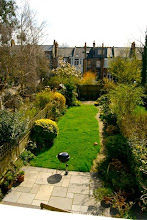

Polridmouth Bay -- as du Maurier fans will know -- is the beach on the edge of the Menabilly estate, along the coastal footpath from Fowey, before it rises up to the Gribbin. It's also recognisable as the beach in 'Rebecca' -- at the end of the path from Manderley to the sea, where Rebecca visits her boat-house, and also where the ship-wreck occurs that plays such a pivotal part in the plot of the novel.
When du Maurier published 'Rebecca' in 1938, she hadn't yet moved into Menabilly -- indeed, as I've already written (in this blog and elsewhere), this was the house that Rebecca rebuilt, in that Daphne used the money she made from the novel in order to lease and restore Menabilly, which was her original inspiration for the story. But she had already seen the wreck at Polridmouth, when she was staying nearby at Ferryside -- subsequently evoked with such drama in 'Rebecca' -- and at low tide, you can still see the remains of that wreck on the rocks. I've been there many times in the past, and seen its bones, like a skeleton only partially submerged in the water -- just like in the opening pages of my book -- but until now, I've never been able to get close enough to touch it.
Polridmouth still feels to me like a slightly melancholy place, especially when the clouds cast shadows over it, but my family disagree (they think I read too much into it; which is perhaps an inevitable consequence of my time researching 'Daphne'). Anyway, here are some pictures...
Oh, and by the way, 'Daphne' is out in America today. Here's a review in the
Los Angeles Times. I do hope the book sails peacefully into new waters...



















